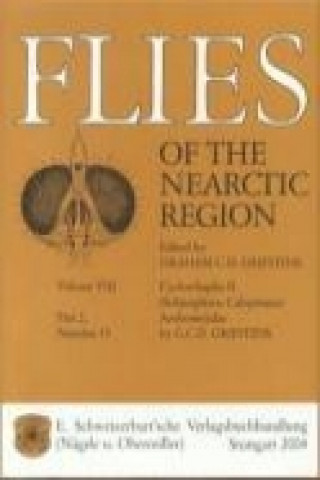
Kod: 12602221
Flies of the Nearctic Region / Cyclorrhapha II (Schizophora: Calyptratae) / Anthomyiidae
Autor Graham C Griffith, Graham C Griffiths
In the present work discussion of the relationships between the genera of Anthomyiidae and the characterization of the family itself will be postponed until after the treatment of genera and species. This will allow prior publicat ... więcej
- Język:
 Angielski
Angielski - Oprawa: Miękka
- Liczba stron: 150
Wydawca: Schweizerbart Sche Vlgsb., 2004
- Więcej informacji o książce

Zobacz książki o podobnej tematyce
-

Dune
50.34 zł -3 % -

Haunting Adeline
125.51 zł -1 % -

Berserk Deluxe Volume 2
212.74 zł -1 % -

White Nights
10.94 zł -28 % -

Powerless
48.63 zł -11 % -

Atomic Habits
57.37 zł -28 % -

Dune Messiah
46.22 zł -3 % -

Berserk Deluxe Volume 3
217.87 zł -3 % -

One Day
34.26 zł -44 % -

Berserk Deluxe Volume 1
211.33 zł -2 % -

Iron Flame
60.99 zł -28 % -

Surrounded by Idiots
36.67 zł -28 % -

Harry Potter and the Prisoner of Azkaban (Minalima Edition)
170.03 zł -2 % -

Gravity Falls Journal 3
89.03 zł -

Heaven Official's Blessing: Tian Guan Ci Fu (Novel) Vol. 1
89.43 zł -

The Creative Act
102.70 zł -12 % -

Dune
47.22 zł -23 % -

Hunting Adeline
126.01 zł -4 % -

A Little Life
48.63 zł -11 % -

Children of Dune
46.62 zł -2 % -

Heaven Official's Blessing: Tian Guan Ci Fu (Novel) Vol. 2
77.57 zł -14 %
Powiadomienie o dostępności
Wpisz swój adres e-mail, aby otrzymać od nas powiadomienie,
gdy książka będzie dostępna. Proste, prawda?
Więcej informacji o Flies of the Nearctic Region / Cyclorrhapha II (Schizophora: Calyptratae) / Anthomyiidae
 Opis
Opis
In the present work discussion of the relationships between the genera of Anthomyiidae and the characterization of the family itself will be postponed until after the treatment of genera and species. This will allow prior publication of the generic revision by Dr. Verner Michelsen (based on his thesis defended in 1981), which promises to contain new information. The recent monograph of Palaearctic Anthomyiidae by Hennig (1966a-76a) made considerable progress towards clarifying the identity of the Palaearctic species, which were previously in extensive confusion due to inadequate descriptions and lack of study of type specimens. Hennig's work will be used here as the authority for the identity of species described from the Palaearctic Region, where no contrary information has since come to light. However, it should be remarked that Hennig's study of the older European types was incomplete, and some nomenclatural changes are resulting from further studies of old collections by Michelsen and Pont. Knowledge of the Nearctic fauna of Anthomyiidae lags behind that of the Palaearctic fauna, a situation which it is the aim of this publication to rectify. The work of Dr. Hugh Huckett, for sixty years the only North American taxonomist working on the family, while an improvement over earlier literature has several deficiencies. Many species cannot be recognized from his descriptions due to lack of information on the terminalia. His association of the sexes was often conjectural and unreliable (many of his "allotypes" not belonging to the same species as his holotypes). And he proposed many synonyms for species already described from Europe. In order to place the taxonomy of this family on a firmer basis, it is intended to examine the terminalia of as many as possible of the holotypes of species described from the Nearctic Region. The limits of the family Anthomyiidae as a monophyletic group still need final confirmation. In most of the character sequences so far analysed the genera included in Anthomyiidae show relatively primitive (plesiomorphous) conditions, and the suspicion thus arises that we may not be dealing with a monophyletic group but with a non-monophyletic assemblage of primitive subgroups of Calyptratae. In his discussion of this problem Hennig (1976a: ii) has, however, been able to indicate one modification (apomorphous character) which suggests that the Anthomyiidae in the sense of his work are indeed monophyletic. This is that the partially fused cerci (mesolobus) have continuous sclerotized connections with the inner surfaces of the gonostyli (called surstyli in Hennig's work), instead of forming articulated joints with them (Zapfenverbindung) as in most other Calyptratae. The author agrees that this is an important apomorphous character, and it convinces me to accept Hennig's family concept at least provisionally. Further review of this problem must await publication of Michelsen's work. No attempt will be made to describe larvae (or other immature stages) in this treatment. The larvae have been described for so few Nearctic species that any comprehensive treatment is impossible at this time. But where larval descriptions have been published, the references will be given.
 Szczegóły książki
Szczegóły książki
- Pełny tytuł: Flies of the Nearctic Region / Cyclorrhapha II (Schizophora: Calyptratae) / Anthomyiidae
- Autor: Graham C Griffith, Graham C Griffiths
- Język:
 Angielski
Angielski - Oprawa: Miękka
- Liczba stron: 150
- EAN: 9783510700271
- ISBN: 3510700279
- ID: 12602221
- Wydawca: Schweizerbart Sche Vlgsb.
- Waga: 350 g
- Wymiary: 248 × 171 × 13 mm
- Data wydania: 12. October 2004
zadowolonych klientów
Od roku 2008 obsłużyliśmy wielu miłośników książek, ale dla nas każdy był tym wyjątkowym.
Copyright! ©2008-24 libristo.pl Wszelkie prawa zastrzeżonePrywatnieCookies



 21 milionów książek
21 milionów książek Dostawa 10.99 zł
Dostawa 10.99 zł (32) 444 93 66 (8-15.30h)
(32) 444 93 66 (8-15.30h)